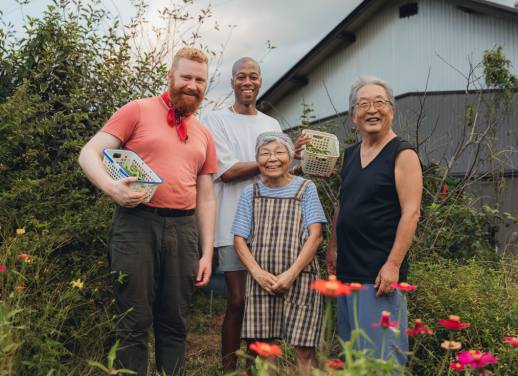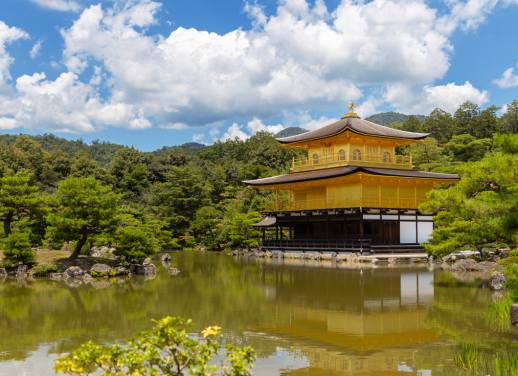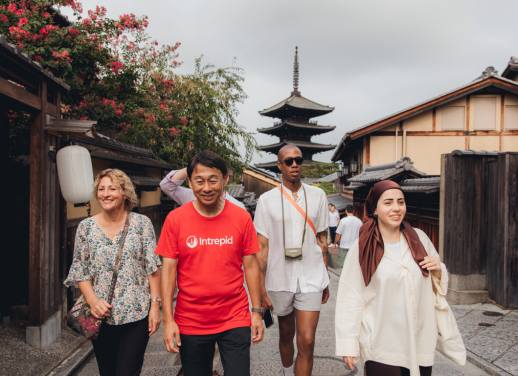Using a sensory anchor, like a taste or smell, is my favourite way to bring myself into the present when I’m somewhere so stunning that I’m in danger of becoming a spectator.
It was either the incense or the ice cream that did it that day.
Reaching the beautiful shrine at Kumano Nachi Taisha has marked the end of countless journeys for pilgrims on Japan’s Kumano Kodo over the last 1000 years. I was delighted to end my long walk and be able to count myself among that number.
The trek is still a huge stand-out from my time in Japan. The scenery was stunning, but the ways I was able to participate in local culture along the way is what made the Kumano so distinctive for me. The texture of the tatami mats at the ryokan, woody mushrooms from the surrounding mountains, sulphurous steam at the local onsen; these are the things that turned a beautiful walk into an incredible experience.
EXPLORE OUR FULL RANGE OF SMALL GROUP ADVENTURES IN JAPAN NOW
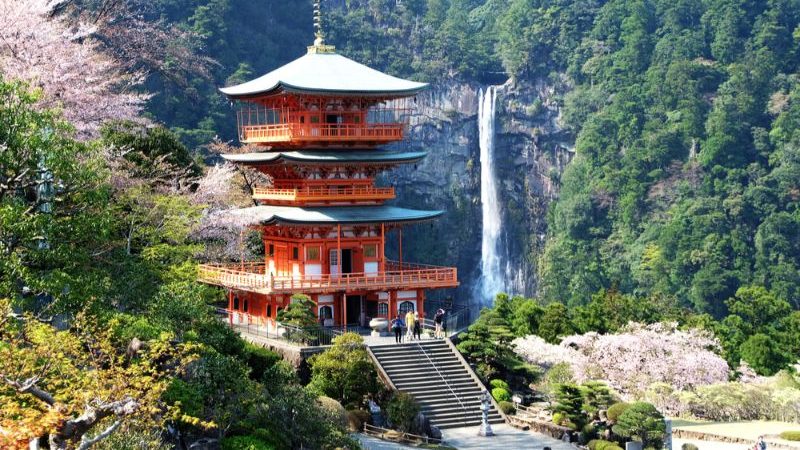
Photo by Piyawannee Sadsumpan.
I’d count myself as more of an enthusiast than a hardcore outdoors woman. I tag hikes onto my trips to experience nature, not to conquer it. So arriving in Osaka, my excitement was tinged with a little bit of trepidation. I love walking, but was I fit enough to be part of a pilgrimage? I’m so happy I didn’t let that put me off.
Wakayama is a mountainous region, so there were definitely sections that got my heart pumping and gave my walking poles a workout. However, the Kumano is also very popular with Japanese retirees and I met people of all sorts along the way. I took my time, smelled the cedar and listened to the water, enjoying the stillness as much as the exercise. Many small Oji, or demi-shrines, pepper the landscape between the big headliners; intended to watch over pilgrims, they were perfect places to pause and rest along the way.
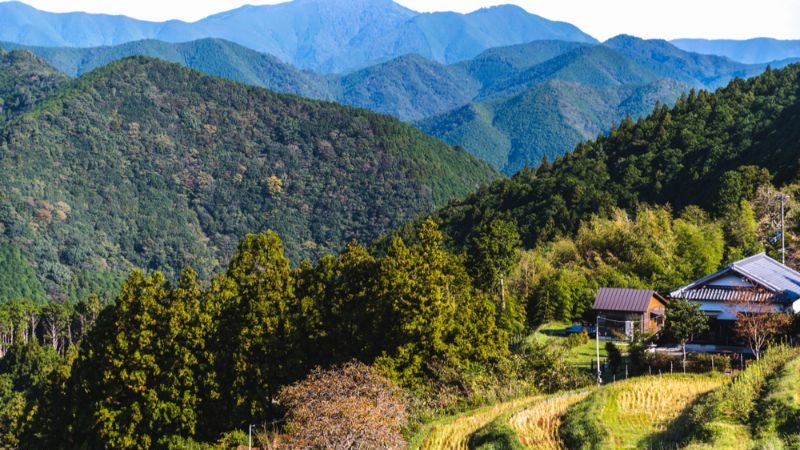
Photo by Cidale Federica.
Yunomine Onsen is a perfect introduction to the Kumano. A bunch of charming little inns perched on the hillside surrounding an 1800-year-old hot spring. The steamy little hamlet sings with history and ryokan here have been hosting pilgrims for generations. It’s a distinctive place that felt frozen in time, despite a steady flow of visitors.
This was my first ryokan experience and I was immediately charmed by the way they blend the hospitality of a hotel with the immersion of a homestay. It was wonderful to shed my street clothes and change into the provided yukata and slippers. My stays were half-board, which meant family-style meals for dinner and breakfast; the food is all part of the wellness philosophy of the region and many ryokan specialise in “Kumano Yakusen Ryori” or “Kumano Medicinal Cuisine”, made with fresh, local ingredients, to keep the body, mind and spirit healthy. It’s not fussy, but every meal was memorable and delicious.
RELATED: WHAT TO EXPECT IN A TRADITIONAL JAPANESE RYOKAN
A soak in my ryokan’s private onsen and an early night had me rearing to go in the morning. I started the day by boiling two eggs in the Yunomine hot spring before hitting the road. I don’t know if it was the medicinal water or the steady climb through the forests, but they were the best-boiled eggs I’ve ever eaten. By the time I reached the Hyakken-gura lookout, I had resolved that slow food was likely to be as important to my personal pilgrimage as slow walking. I made an offering at the Oji, shed a tear at the incredible view and I headed down the hill feeling like part of something magnificent. That’s the secret of the Kumano: making the ancient accessible.
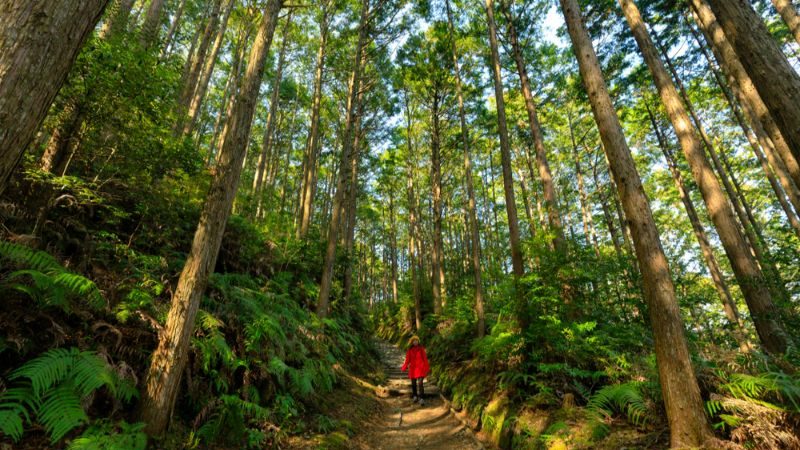
Photo by Stephane Bidouze.
Koguchi is a larger town with a lovely public onsen. I arrived in time to catch the sunset from a little outdoor pool. We English aren’t famous for our body confidence, but I was emboldened by a day on the trail and feeling quite at home among the locals and my ‘fellow pilgrims’ by then. The traditional pre-bath ritual is a great way to acclimatise if you’re feeling at all nervous. Once you thoroughly scrub your aching limbs you feel so great that you quickly realise that nobody’s remotely interested in your pot belly. It’s so liberating, I left convinced that an hour at an onsen can change your entire relationship with your body, it was that wholesome.
RELATED: YOUR GUIDE TO JAPAN’S BEST SECRET SUNRISE SPOTS
It was also a great way to prepare for the tough three-hour climb at the beginning the final day of the Kumano Kodo, as all three pilgrimage routes converge in the approach to the grand shrine, Nachi Taisha. The locals call this the Hara-kiri, or body breaking climb, and I’d be lying if I said I wasn’t worried by the dramatic stomach-slicing gesture that my leader kept making as she explained the route and options to us. It’s a 7-8 hour walk in all and taking the short cut (by bus to Nachi waterfall) is something you need to decide before setting off.
There’s no rushing this climb, whatever your degree of fitness. After a while, winding your way up the mossy stone steps becomes quite meditative; just hard enough to distract you from your everyday thoughts, but repetitive enough to leave room for new ones. By the time I reached the ruined tea house that marks the rough halfway (and lunch) point, I felt quite serene and proud. It’s here that thousands of silent prayers are answered, with the terrain plateaus giving brief glimpses of the Pacific through the trees before you begin the long descent. My legs were quite wobbly by the time I started to smell the incense and hear the sounds of the Nachi Taisha.
Picking my way down a seemingly endless staircase and exiting the trees into a bright, bustling precinct. A stunning setting worthy of a grand shrine, home to both Shinto and Buddhist traditions and a beautiful pagoda set beside one of Japan’s largest waterfalls. I join the crowd of worshipers, light a stick of incense and say my prayers. The rush of relief and wonder is something quite unique, but also common to the millions who’ve walked this path before. There’s something so comforting in that, so humbling and so special that it calls for ice cream.

Photo by Shantel Wetherall.
Interested in a forest trek, complete with temples, onsens and ice cream? Join us on our 8-day Japan: Koya-san & Kumano Kodo trek now. ‘
Feature photo by Stephane Bidouze, Shutterstock.

